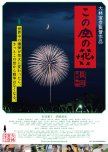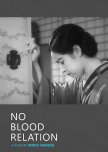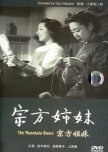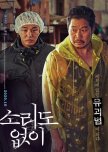
Two children are seen searching for anything to eat, knowing they are starving and could die. Their world is decaying and crumbling apart. Every step crunching on the ruins of civilization emphasizes how they live in a godforsaken land. They search a blown-out building and find a man tied and chained to a wall. Realizing he might be someone else’s food cache; they work quickly to secure him for themselves. Is he dead or still alive? And does that even matter anymore?
This is not a great film, but one that people who want to annihilate others should see. Governments who believe there is such a thing as “limited” nuclear war should see. Our mutually assured destruction can put us in a position where those who survive have only the bodies of other unfortunate souls to feed upon. Hu Bo’s pessimistic vision of the future is a dark place of utter misery. Children who should be giggling, playing, and well-fed have become scavengers in a wasteland spiraling down a hole deeper than any well.
10 October 2024
Considerați utilă această recenzie?

Casting Blossoms to the Sky
3 oamenii au considerat această recenzie utilă
"War is fun when you're winning"
Casting Blossoms to the Sky is an anti-war film that took 2 hours and 30 minutes to try and make its point. Much was made of, “That which fills the gap is imagination.” Thus, characters spoke directly to the audience and ghosts walked about as if that was all very normal. This film was not what I expected after reading the synopsis. The victims of the 2011 earthquake and Fukushima disaster were almost an afterthought. Instead, the majority of screen time was dedicated to the 1945 bombing of Nagaoka a couple of weeks before the end of the war. The premise centered upon how fireworks and bombs are similarly made, both being explosives while one celebrates beauty and the other destroys it.Rieko Endo is a journalist who decides to go to Nagaoka for two reasons. She wants to find why the town opened its doors to refugees from the earthquake/tsunami and nuclear power plant disaster. Her ex-boyfriend also sent her a letter inviting her to a play at his high school. While in Nagaoka she meets numerous people connected to the bombing from 1945 and the making of fireworks.
This is the type of reflection and healing film I would normally love, but I did not love how it was pieced together. Characters speaking to the audience was distracting, though it dissipated as the film went on. There was repetition upon repetition. Some scenes from the bombing and making of the school play were replayed over and over and over and over. It began to dull the instrument of storytelling. The flashbacks almost gave me whiplash. The flashbacks would bounce around 2011, then to the 2006 earthquake, to 18 years ago when Reiko was with her boyfriend, flashbacks to another woman’s breakup, flashbacks to the Boshin War, along with the history of making fireworks and their use in the area, and flashbacks among numerous people and events leading up to, during, and after the Aug. 1, 1945 bombing. The bouncing around and circling back was headache inducing.
“We have nothing to do with war.”
I still have no idea what Rieko was talking about when she kept saying this regarding her broken relationship. The acting was serviceable though Matsuyuki Yasuko did more posing than emoting. All of the ex-boyfriends involved didn’t exactly evoke emotion as there were no interactions with the ex-girlfriends for the most part. Characters spoke fast and earnestly. There were unicycles everywhere, not quite sure what they symbolized. The real and surreal were often intermixed.
You will need a strong stomach for the vivid descriptions of what fire and bombs did to the human body. While I applaud the pacifist agenda, there were times it didn’t come across very realistically. “If they could see us, they wouldn’t bomb us.” The Japanese soldiers could see the civilians in Nanking and had no problem mowing them down. The comfort women were mentioned and then just as quickly dropped. The Japanese soldiers saw them and sexually abused them in every vile way possible. If every gruesome detail had to be described during the bombing repeatedly and in Soviet Union POW camps, maybe the lack of humanity for the other should have been equally described. There were plenty of atrocities to go around. And that would have made the argument stronger. During war, terrible things happen to real people. People with families, friends, jobs, children, and dreams. No one wants to suffer horrible deaths or imprisonment. No one wants to be forced to do things against their will. No one wants to see their town and home destroyed. No one wants to see their children starve to death. Why not treat everyone with respect and work through problems with words? Even if we got rid of bombs people would go back to killing each other the old-fashioned way with guns, swords, arrows, knives, spears, clubs, rocks, and/or fists. The problem lies within us, that thing that must be healed. It’s more important now than ever as we live in a world with diabolical weapons. Director Obayashi already had my attention and concurrence with, “Be friendly to each other.” Would that it were that easy.
“We have to use the pain caused by war for peace.”
The Nagaoka officials tied the fireworks into a healing and memoriam display though it was traumatizing for some of those who lived through the bombing. Many modern veterans of different wars and skirmishes have similar PTSD reactions to fireworks—the fireworks might be pretty but they sound too much like bombs. In 2011 and 2012 there were firework displays honoring both the victims of Nagaoka and Pearl Harbor in both places which was a nice reaching across the ocean in a display of peace.
“There’s Still Time Until a War.”
To stop the war? Or live life to the fullest? Casting Blossoms into the Sky was a bold, imaginative effort to show the horrors of war and why war must be avoided. The film could have been trimmed by an hour and had a stronger impact for me. I began to feel like I was stuck in a death loop watching the same gruesome events over and over again. Instead of convincing me that peace was possible it made me feel that war, like death, is inevitable.
8 October 2024
Considerați utilă această recenzie?

Underground Monster
3 oamenii au considerat această recenzie utilă
What makes a monster?
Underground Monster’s poster looked like a cute kid’s movie. Don’t you believe it. Older children might be able to watch it but there were some scary creepy crawlies and two-legged monsters as well. This was a movie that couldn’t quite decide whether it wanted to take itself seriously or be a comedy so it threw a little of everything at the wall to see what would stick. It could be hard to tell what stuck with all of the trash heaps lying around.Construction workers digging a new tunnel come across a cave filled with giant piles of trash. It’s not long before they realize the trash is hiding an even more giant monster. Not everyone makes it out of the hole. On the surface and down the road Xiao Jie and his father He Chi are spending time together. He Chi makes his living collecting junk and is divorced from Xiao Jie’s mom. When the construction worker’s truck speeds by, a crate with a large green egg falls out. He Chi picks it up to see if it’s worth anything. Ex-wife Wu Lin Na is waiting at his home and not happy that Xiao Jie is spending time with his dad. Later that evening, the egg hatches and mama monster comes looking for her baby.
The Underground Monster looked like a combination of Disney Mermaid’s Ursala and The Simpson’s Kang. The CGI was okay but not great. They did give the monster a very expressive face, especially after it kidnapped Xiao Jie thinking he was her baby. The bond between the two was endearing. The trash cave became crowded as both parents, a mad scientist with a beard so fake you could see the tape holding it on and his kookier assistant, as well as a group of vengeful construction workers converged with different goals for the protective monster.
The slapstick scientist and assistant ruined the mood of the film for me. While I was happy to see The Snow Monster again and the snow sharks from that movie (Snow Monster 2019), it was not worth the over-the-top acting by the two while the devastated parents played their parts straight as did the murderous tunnel workers.
There were a few cute and emotional scenes in Underground Monster between the child and monster. There were also some disturbing ones. The film drove home the point that humans and their propensity to trash the planet might be the true monsters. They were also the ones who wanted to kill first and ask questions later. The movie reminded me of the song from Beauty and the Beast:
“We don't like
What we don't understand
In fact it scares us
And this monster is mysterious at least
Bring your guns!
Bring your knives!
Save your children and your wives
We'll save our village and our lives
We'll kill the Beast!”
7 October 2024
Considerați utilă această recenzie?

Diamonds are a girl's and space kaiju's best friend!
Toho and Honda Ishiro stepped out of their comfort zone with Dogora. This massive tentacled space monster wasn’t a guy in a rubber suit which was a nice change of pace. As with many of these kaiju films from the 1960’s I was left wanting more monster and less people.An international gang of jewel thieves is blamed for jewel thefts, well, internationally. Trouble is, they only pulled one of the jobs. When they tried stealing diamonds in Tokyo a glowing blob swept them off their feet and melted the vault door. Also involved with diamonds is Dr. Munakata who studies crystalline geometry with the help of his lovely secretary Masayo. On the case of the jewel thefts is Det. Komai. Another player is the shadowy American Mark Jackson who always seems to show up when diamonds or the giant space monster are near. Masayo’s brother is a space scientist who is concerned about satellites that have recently been destroyed. It doesn’t take long, actually it took longer than it should have, for everyone to realize that Dogora was funneling up huge amounts of coal and diamonds from around the world. Dr. Munakata realizes if Dogora is not stopped it will spell Doomsday for the people of Earth when she turns her carbon hunger toward the carbon based people inhabiting the planet.
This film was more cops and robbers than monster flick. While Dogora provided stunning spectacles of destruction, the police and jewel thieves had tunnel vision when it came to the diamonds. Much of Dogora played out like some of the humorous jewel theft movies of the time such as the original Pink Panther and Ocean’s Eleven. Everyone seemed to take another monster in stride. In fact, the police captain told Komai to stop messing around investigating the monster and focus on the human jewel thieves despite the fact that the two were connected.
Special effects director, Tsuburaya Eiji, created something new and beautiful with Dogora. Around the 50-minute mark Dogora showed herself in all her glory, like a glowing jellyfish or cephalopod. She was graceful and ethereal and decidedly deadly as she destroyed Wakato Bridge. Her sparkling amoeba shaped children/minions(?) did her bidding around the world. Reverse tornadoes sent coal, trucks, smokestacks whatever was in the way of her carbon snacks upward. The miniatures were interlaced with real military weapons and people. The ultimate weapon was wackier than in other kaiju films, but at least it wouldn’t destroy the Earth.
All of the performances were good though I was pleased that Robert Dunham was cast as the American as he could speak Japanese fluently instead of being dubbed. He also didn't have to wear the embarrassing costume he had to don for Godzilla vs Megalon. Toho monster regular Koizumi Hiroshi had a small part as a scientist. Bond girl, Wakabayashi Akiko, played a femme fatale in the thieves’ gang who became too greedy for her own good. Handsome Natsuki Yosuke’s Komai made for a great straight man against the quippy Mark Jackson. Yet despite having a strong cast, the heist script was not nearly tight enough and was often repetitive. Despite its faults, the human characters were stronger than in many of these old kaiju films.
I probably rated Dogora too high in comparison to other kaiju flicks from the timeframe. I was just happy to see a more creative monster. The film would have been much better if they’d trusted the balletic decimator to carry the show instead of the bumbling cops and robbers.
5 October 2024
Considerați utilă această recenzie?

Some aliens can't take the heat
Only a few years after Godzilla stomped through Tokyo and Rodan stirred up trouble, Japan had to deal with aliens. The Mysterians wanted to set up housekeeping on the island and to mate with Earth women. They had a giant robot and destructive ray while the humans had two plucky scientists.Shiraishi Ryoichi is convinced that aliens are lurking in the area around Mt. Fuji. Most of his colleagues think he needs a vacation, until strange events begin to take place in his village. When an underground alien fortress rises up for all to see scientists Adachi Tanjiro and Atsumi Joji realize Ryoichi had been right all along. The Mysterians blew up their own planet during a terrible war and are looking for a new place to hang out. They also need to breed with Earth women because they have been unable to reproduce healthy children on their own since their war. Needless to say, the Earthlings aren’t ready to acquiesce to the Mysterians’ demands and start to work on building a weapon to counter the deadly ray gun the aliens use.
This was another Toho film directed by Honda Ishiro with music by Ifukube Akira. The miniatures and overlays were all well done. This was before many of the miniature towns started looking like cardboard boxes as they stretched the Godzilla franchise out on smaller and smaller budgets. There were also some real-world military weapons and planes interspersed throughout the film. The Mysterians had one of the first big screen TVs, 10 years before Capt. Kirk on the starship Enterprise. Shimura Takashi, famous for his work in Kurosawa Akira films, played in several of these Honda films, this time as the lead scientist. Hirata Akihiko, the hero of the original Godzilla, played a more morally complex character in this film. As with other films in the early years of the Toho monster flicks, there was a moral lesson to be learned. An all out nuclear war would all but ensure humankind's destruction so another way of combating the Mysterians had to be found.
The Mysterians had its moments. I mean, who wouldn’t want to see a giant laser fight in front of Mt. Fuji? Where the film lacked for me were the Mysterians. They were a little too mysterious in their colorful Power Rangers costumes. We never see their faces or hear their diabolical plan for world domination. Most of the film was from the scientists’ point of view and their assumptions that the aliens were up to now good. The film could have also used more of Moguera, the giant robot. For a 1957 sci-fi film, the special effects were sufficient as was the acting, surprisingly. I just needed a little more menace from the creatures who arrived from their blown-up planet via Mars, via the moon.
3 October 2024
Considerați utilă această recenzie?

"It was no dream"
Kwaidan is a 1964 film that contained four unrelated ghost stories. The film drew most of its material from Lafcadio Hearn’s 1904 book called Kwaidan: Stories and Studies of Strange Things. Director Kobayashi Masaki crafted each stylized story much like a painting. The skies were often brightly painted backgrounds with each vignette taking place primarily on a soundstage. These were not terrifying or gory tales, more like eerie, karmic, Twilight Zone episodes.1) The Black Hair/Kurokami (B)
An impoverished ronin discovers what goes around comes around aka payback is a bitch when he leaves his loving wife to marry up and take a new position.
2) The Woman of the Snow/Yuki Onna (B+)
A young woodcutter is spared by a snow witch on the grounds that he never tell anyone he saw her. He learns the lesson to never betray a woman.
3) Hoichi the Earless/Miminashi Hoichi no Hanashi (B)
Blind, kind, Hoichi is a young monk at a temple not far from where an epic battle took place 700 years before. The ghostly Heike clan calls upon him to sing the tales of their failed battle night after night. He pays a painful price for his freedom.
4) In a Cup of Tea/Chawan no Naka (B-)
Can you swallow someone’s soul when drinking a cup of tea? A writer receives a proper punishment for writing an open ending to his story.
I enjoyed the stylized view of each of the stories with most having a stage production look and feel. They often appeared surreal, especially Yuki Onna’s swirling eyes in the sky. Each varied in length with Hoichi the Earless being the longest (maybe too long) and In a Cup of Tea being the shortest (maybe not long enough).
The cast for each story was strong. Nakadai Tatsuya played the naïve woodcutter and Kishi Keiko played the complicated Yuki in Yuki Onna. I love his wild eyes though he was the babe in the woods in this segment. Shimura Takashi as a Buddhist priest tried to help the blind Hoichi who was bound to his ghostly visitors each night. Too bad his character didn’t have a strict attention to detail.
Each of the four stories took a different approach to the supernatural though all of the main human characters paid a price for their encounters. Kwaidan had strong performances, taut stories, and a mesmerizing artistic appeal to it. There was an almost poetic rhythm to the moralistic storytelling. While these were technically horror stories, they were the type you could see people telling around a campfire, preferably with any powerful talisman available hanging around their neck.
3 October 2024
Considerați utilă această recenzie?

No Blood Relation
3 oamenii au considerat această recenzie utilă
What does it mean to be a mother?
No Blood Relation was the second oldest surviving film from director Naruse Mikio. Like Ozu Yasujiro, many of his early films have been lost to the ravages of time. Based on a novel by Yanagawa Shunyo, Naruse asked the question, “What makes a mother?” Is it biology or nurture? A little girl would be torn between the only mother she’d ever known and the mother who came to town to claim her.Famous actress Tamae Kiyooka returns home to Japan after making her fortune in the United States. First on her list of things to do is to regain custody of the daughter she abandoned as a newborn when she ran off with her lover to pursue her career in Hollywood. Coincidentally, her ex-husband is filing for bankruptcy and being hauled off to jail for reasons related to the downfall of his company. Kiyooka is unaware of how deeply Shegiko and her stepmother love each other. Masako has raised Shegiko as her own with Shegiko never knowing she’s not her biological mother. Kiyooka uses Atsumi’s mother who is disgruntled by their backward step in fortunes to kidnap Shegiko. Neither the little girl nor her stepmother are willing to be separated, but Kiyooka believes she has the moral high ground with the blood relation and is wiling to be patient.
Okada Yoshiko had the difficult job of making Tamae Kiyooka sympathetic. The script didn’t help much but her ability to convey Kiyooka’s sorrow and frustration over her daughter not only not recognizing her, but hating her as well came across wonderfully nuanced. Because Kiyooka remembered her child it never occurred to her that Shigeko would feel no connection to her. The consequences of her choices tumbled on her like a falling spotlight. “Is the bond between mother and child so fragile?” When you’ve put no effort into it for 7 years, yeah, it’s pretty fragile. I found Okada to be a fascinating person. The actress led a complicated life with various lovers culminating with a move to the USSR in 1938. Instead of a happy ending they were jailed and tortured as spies. She was incarcerated for 10 years and her lover died before she ever saw him again. Okada went back to Japan to make a few films in the 1970’s but returned to the Soviet Union not long afterward. Her story would make an intriguing film.
Tsukuba Yukiko as Atsumi Masako gave her character heart and a gentle fierceness as she fought for the daughter she loved. Traditional Masako was shown in contrast to Kiyooka’s modern and Westernized woman. Kiyooka deserted her daughter for a career while Masako began a job to keep her daughter. Oka Joji played the Atsumi’s friend, Kusakabe Masaya. This was a distracting casting choice for me. Nara Shinyo as Atsumi was homely and petite. I couldn’t help shipping handsome and imposing Kusakabe with Masako. Kojima Toshiko was charming as Shegiko, the precious child two mothers fought over. Katsuragi Fumiko played Atsumi’s greedy mother who proved that gold is thicker than blood.
I watched this silent film on the Criterion Channel where the film had an unobtrusive piano accompaniment added. There was significant salt and pepper pocking as well as white lines on some frames. The intertitles were used efficaciously and provided the necessary information needed with one exception. I wasn’t sure why Atsumi was sent to prison. Naruse made several awkward choices with the use of speedy extreme closeups interspersed with choppy shots of people and exteriors. His later work would flow much better. The bumbling brothers felt like they were part of different movie when they were clowning around all while two women fought a devastating battle for the affections and custody of a child.
With no spoken word, compelling performances were a must for silent films. No Blood Relation was fortunate to have quality actors conveying the film’s message. “It’s raising a child, not giving birth to one that makes a woman a mother.” Kiyooka had to learn the difference between love and possession while Masako had to dig deep to fight for the daughter she loved. If you enjoy Naruse’s films this poignant story about maternal love and what constitutes a family is one to try.
23 September 2024
Considerați utilă această recenzie?

The Munekata Sisters
3 oamenii au considerat această recenzie utilă
"Being new is all about not getting old"
The Munekata Sisters is an Ozu Yasujiro film based on a novel serialized in a newspaper which gave it a slightly different flavor than the typical Ozu film. There was still his usual battle between a traditional lifestyle and the encroaching modernized world. This time the conflict between old and new took place between two sisters.Energetic Mariko lives with her older sister Setsuko and drunken, sullen, unemployed brother-in-law Mimura. After reading Setsuko’s diary she realizes that her sis is not only in a loveless marriage but lost out on her true love 15 years ago. True love Hiroshi is back in town and Mariko begins spending time with him. While Mariko wants Hiroshi and Setsuko to reunite, her very traditional sister would never consider such a thing.
Tanaka Kinuyo played the mature, well-spoken, dutiful wife in a kimono. Despite the fact that her husband barely gave her the respect the lowliest servant would receive she kept her cool and served him politely. Takamine Hideko turned on her 100-watt smile and injected Mariko with boundless effervescence. Mariko wore high heels, nail polish, and western style clothing and hated old-fashioned things while Setsuko loved visiting gardens and temples. Uehara Ken’s Hiroshi was harder to pin down. He was amiable but not terribly decisive and tended to go with the flow. Dependable Ozu regular, Ryu Chishu played the father but was only in a couple of scenes. The father’s most important advice was for his daughters to be true to themselves whatever that might be. Ozu never was concerned with actor’s ages, Ryu was only 5 years older than his “daughter”, Tanaka. With 15 years between them Tanaka’s relationship with Takamine felt more motherly than sisterly. I kept hoping one of Ozu’s trains would run over Yamamura So’s Mimura. “A wife’s the epitome of stupidity…just a convenient tool. Like a doorbell...The problem is drinking and doing nothing is hard to give up.” I cheered when fearless Mariko stood up for her long-suffering sister. The old ways were simply too deeply ingrained in Setsuko which could be incredibly frustrating for a modern viewer.
The Munekata Sisters stretched Ozu a little out of his comfort zone with more overtly emotional scenes. The comedy worked for the most part with the exception of Mariko’s overused kodan style of storytelling. Still in play were Ozu’s meditative scenes of architecture and a father quietly appreciating a nightingale’s song. Ozu tried to show that both the old and new had value and that fads that changed within a short time were not as important. As Mariko said about she and her sister, “We grew up in two different worlds.” With the ending Ozu provided I’m not sure he made the case for outdated things still being relevant, though the impacted character was true to herself.
9 September 2024
Considerați utilă această recenzie?

Enter the Forbidden City
3 oamenii au considerat această recenzie utilă
"Devotion to art is like a religious belief"
Hu Mei’s passion project about the nascent Beijing Opera took six years to come to fruition. Not even the studio burning down could thwart her. Enter the Forbidden City was a beautifully shot film that took time to find its footing but once the two singers began to share the spotlight, the “fascination” began.Singer Yue Jiu is betrayed by jealous rivals and banned from the capital for life. In the same city where he is in exile, Run Sheng is facing discrimination because he is an entertainer. Back in the capital, the emperor wants to invite 100 theatrical troupes to The Forbidden City for his 80th birthday but the cost is too prohibitive (17,800 taels of silver per troupe!). If they can pay their own way, the entertainers are welcome to come. Princess Feng attends Run Sheng’s shows and has taken an interest in him as a patron and as a woman. The troupe’s travel plans run into a financial snag until they are offered what they need to appear before the emperor, but for a dangerous tradeoff.
Hu Mei’s movie was lush and color saturated. The costumes were elegant and she often filmed on location which added a realism to the setting. Emotional music swelled in the background, a nice break from the actors’ singing performances. All of these things contributed to a well-made film which was pleasing to soak in. Where the film lapsed for me was the first third of the film. Jiu was the initial character shown so he imprinted on me. After he was quickly kicked out of the capital, the film focused on Run Sheng and the abuse the troupe members took from the locals. This left me wondering what happened to Jiu and where the film was going. Run Sheng’s elopement gobbled up much of the running time and had very little to do with the overall story development except to give him more depth and appear unstable. I also have a complaint that was completely out of Hu Mei’s hands---the official subtitles were white and miniscule. They were difficult, sometimes impossible, to read and a real eyestrain.
The strength of this film lay in showing how the actors worked and practiced. Ma Yi Li as Princess Feng added a feminine element even when she was dressed as a man. She wasn’t strictly fangirling, she had precious tips for the overconfident Run Sheng. Jiu’s complete commitment to his craft bordered on obsession and inspired Run Sheng. Fu Da Long was exceptional as Yue Jiu, whose every movement was graceful and specifically designed. Ma Yi Li is fast becoming a favorite with her striking screen presence, she balanced the princess’ strength and vulnerability with ease.
Enter the Forbidden City was inspired by real stories and events and a treat for the eyes. Though not my culture or history, I enjoyed learning about some of the history of early Beijing Opera. It was also one of the rare times an emperor wasn’t portrayed as a monster or a complete idiot which was refreshing. Please don’t tell me if he was a monster and/or idiot in real life. ^^
27 August 2024
7.25
Considerați utilă această recenzie?

Haruko's Paranormal Laboratory
3 oamenii au considerat această recenzie utilă
"Do you have a warranty?"
If you are in the mood for something super quirky that looks like it was made on a shoestring budget, search no further, Haruko’s Paranormal Laboratory is here to serve your quirky needs. It felt like writer/director Lisa Takeba brainstormed as many strange things as she could and then strung them all together in a surreal story.Haruko is an odd little duck who has always desperately wanted to have a paranormal adventure. She’s been begging for a UFO to visit her for years especially after her brother was taken up in one. She complains about every show on her 1953 television set. Unseen to her a counter flips over a number for every complaint and curse word she utters. When it hits 10,000 her television turns into a man with a tv on his head and a super dong for other activities. They quickly become sex buddies. After a while he tires of being a house boyfriend doing all the domestic activities and goes out to find a job. Fortunately for him, he speaks 12 languages and lands a couple of teaching jobs on TV and the radio. Haruko works with a sex crazed woman turned “artistic” arsonist. Her next-door neighbor makes sex art out of veggies. The most dedicated TV licenser on the planet makes sure she pays her fees whether the television works like a normal one or becomes a man. There’s an “artistic” masked coin bandit and a Friday the 13th Jason cosplayer who follows her around. She also finds out some kinky news about her father and mother.
I’m sure there was some deeper message and social commentary on feeling socially alienated, the boredom of working a meaningless job, being unable to make your real passion make money (tea stain art?), and only being able to find true love with a television set, but it was a little hard to strain out with all the bizarre paranormal and abnormal people wandering around. If you ever wondered what an R rated Pee Wee Herman’s Playhouse made in Japan might be like, this would come close. Where else could you see a drugged-up television set have a dance-off with a camera?
22 August 2024
Considerați utilă această recenzie?

"You didn't capture me, I came looking for you!"
Directed by Kao Pao Shu and written by prolific writer Ni Kuang, The Jade Fox had non-stop action and all sorts of crisscross double cross action. There was also a female villain with a tricked-out war chair. And it wouldn’t be an old school kung fu flick without a secret map!(I’m just going to use the actors’ names for most characters as there are different names floating around). Kao Pao Shu is plotting to take over the kingdom with the help of a secret map. Her main bodyguard is Lo Lieh. Tien “Roc” Peng/The Jade Fox steals the map from her courier. Kao has Lo Lieh deliver an “invitation” at the end of a sword for Nick Cheung Lik to come to Fairy Land. Doris Lung is Lik’s fiancée and she tears up the Jade Fox’s House of Pleasure looking for his pal Lik. In the process of cleaning out the place with her kung fu, she meets the Jade Fox’s other friend, Iron Hand/Eddy Ko and a young prostitute’s son called “Come Again” who was trained in martial arts by a monkey! Whew! Oh, and the Jade Fox’s ex-lover who works for Kao is ordered to bring him to the villainess.
The story bounces around and bodies begin dropping by the dozens as the Jade Fox attempts to track down the head villainess with the aid of Come Again, Doris Lung, and Eddy Ko. Jacky Chen who played an ill-fated hero who unfortunately discovered the deadly traps hidden in Kao Pao Shu’s chair and livery was one of the martial arts directors. He and Chen Mu Chuan had their hands full designing fight choreography for several actors who were not accomplished martial artists. For the most part they succeeded, keeping in mind this was before all the CGI, slow-mo wizardry done now. One of the best and most brutal fights was at the end between two “good” characters. I enjoyed Doris Lung and Eddy Ko’s performances and fight scenes more than I thought I would. Roc Tien wasn’t too wooden and the child character wasn’t overly annoying. Solid wins in this genre.
The story bordered on convoluted but the cast mostly pulled it off when compared to other low budget Taiwanese kung fu films from the time. The biggest detriment to this film was that it needs to be restored. It was quite blurry and zoomed in too much. The only copies I could find were dubbed and the sound wasn’t always great. There were also advertisements showing it was for sale in South Africa during two different scenes in the movie. These later issues were not the fault of the filmmaker so I had to strain all of the distracting later problems out as best I could. My score is probably a little high, even when grading on a curve, but I really enjoyed the bonkers fights at the end as all of the hidden identities and schemes were revealed. As usual, this is only for people who enjoy old kung fu movies, they are definitely a niche genre.
20 August 2024
Considerați utilă această recenzie?

Electric Shadows
3 oamenii au considerat această recenzie utilă
Mao Da Bing is a water delivery boy and in a rush on his bike to make a movie’s showing. He accidentally knocks over some bricks and a young woman clocks him upside the head with a brick and then destroys his bike. At the police station she hands him her keys and tells him to feed her fish by writing on a piece of paper. When he enters her apartment, he sees that it is an ode to film and especially Street Angel with actress Xiao Xuan. He finds her diary and begins to read about her life and how she ended up where she is. As he reads her story, Da Bing also discovers they share a childhood connection.
The flashbacks to Ling Ling and Da Bing’s childhood were sweet and an innocent exploration of friendship and films. Before and after this segment was not as entertaining and contained one too many melodramatic and coincidental moments for me. As a cinephile I can understand the children’s love of film and the role it played before television took over. What I didn’t understand were some of the mom’s inconsistent decisions later in the story. Another mystery for me is what kind of job did Ling Ling have to be able to outfit her apartment like a mini-cinema? Da Bing could barely afford to go to the movies as an adult. They suffered similar situations and Ling Ling’s was compounded by hearing loss.
As much as I wanted to love this film about loving films, outside of the children’s story, the film suffered from too many coincidences and underdeveloped character elements. However, if you can overlook some of those flaws there is still much to be enjoyed in this film about childhood friendship, family, and reconciliation aided by the numerous clips of old Chinese films.
19 August 2024
Considerați utilă această recenzie?

Voice of Silence
3 oamenii au considerat această recenzie utilă
Această recenzie poate conține spoilere
"Once you join a family, you have to pitch in, right?"
Voice of Silence was an amalgam of different genres with results as mixed as the narrative moods. Shots of bucolic farm land and cornflower blue skies camouflaged empty buildings hiding dark, deadly secrets. The acting and cinematography were excellent, I just can’t say that I thoroughly enjoyed what was supposed to be a heartwarming story of a child in jeopardy.Chang Bok and Kim Tae In both have physical disabilities. Chang Bok walks with a significant limp and Tae In is mute. They live amongst beautiful farmland in peasant shacks selling chicken eggs at the market. In their spare time they clean up crime scenes for a gang. They know where all the bodies are buried because they buried them. Things go sidewise when their boss tells them to take care of a little girl who has been kidnapped. Because the kidnappers accidentally grabbed Cho Hee instead of her brother, the father has been haggling with them, unwilling to pay much for her. Tae In takes her home to his small squalid place he shares with his little sister. Cho Hee befriends Moon Ju and helps to civilize the almost feral girl. Chang Bok takes Cho Hee on their jobs and the child scarcely bats an eye at the bloody business. The more her father holds out the more danger the little girl is in even from her well-meaning caretakers.
It felt like I was supposed to become invested in Tae In and Cho Hee’s relationship as the two seemed to bond. In truth, the only characters I cared about were Cho Hee and Moon Ju. Chang Bok and Tae In may have cared about her to a degree but were also willing to hand her over to child/organ traffickers. Unlike church going Chang Bok, Tae In’s moral compass began to point toward protecting Cho Hee. Yet Tae In was still a criminal. When a police officer investigated Tae In’s property, I was hoping she would find the girl, she certainly didn’t deserve what happened to her.
The most fascinating character to me was Cho Hee. What kind of family did she come from that burying a body and bloody scenes didn’t affect her? The film never told us. At every crisis she processed the information and pinned a placid expression on her face. Regardless of any sympathy she felt toward Tae In she was smart enough to realize how precarious her situation was with the two inept criminals surrounded by sharks. Her family might have been reluctant to have her returned but her fate was a terrible end the longer she stayed where she was.
I’m quite sensitive to child in jeopardy films and despite Tae In having a good heart working at a bad job, Cho Hee was in danger. "Once you join a family, you have to pitch in, right?" Just because they made the child an honorary family member while she was a prisoner didn’t mean that what was planned for her was any less heinous. It didn’t help that the film ended as if the writers ran out of paper when typing out the script and decided they’d gone far enough. Open endings are my least favorite and always feel lazy to me like the writer didn’t want to commit to an ending for fear of angering some part of the audience.
Voice of Silence did not fit neatly into any category. Was it a crime drama? There were plenty of bodies. A comedy? Maybe, I laughed once. Social Commentary? The two inept criminals did seem to be forced to work for the gang due to financial hardships in the rural area. Strange Criminal Slice of Life Buddy film? Probably the closest fit. Mostly, the message that came across was that one day you’re hanging someone on a meat hook, the next day it might be you.
16 August 2024
Considerați utilă această recenzie?

"In front of your eyes"
Director Naomi Kawase reflected on different women who were True Mothers in this sensitively told story about adoptive and birth mothers. She also showed how some mothers are mothers in name only while others who have no children of their own nurture those in their care with compassion.Satoko and Kiyokazu find they are unable to conceive a child. When they see a service that connects mothers who can’t raise their child with mothers who want to raise a child, they contact Baby Baton. Hikari is a 14-year-old girl who becomes pregnant and discovers the fact one week too late to have an abortion. Her embarrassed and enraged mother sends her to Baby Baton to keep the news secret. Satoko and Hikari are destined to be connected in the past and future as their decisions change their lives.
Kawase had a solid story to tell, but it oftentimes drifted off into side stories or came across almost like a documentary told in non-linear style. The viewer followed Satoko and Kiyokazu as they traversed the emotionally and physically demanding road of infertility treatments and then through the arduous path to adoption. Teenaged Hikari went from being in love to being pregnant and emotionally abandoned by everyone she cared about. Kawase’s attention to detail was her strength and weakness. While gaining insight into the different people involved was important, I didn’t need to know everything that happened to every character in order to feel emotionally connected to them. At nearly 2 ½ hours, some of the more disparate stories could have been more judiciously edited.
The primary actors did a fine job. Iura Arata as the loving husband conveyed Kiyokazu’s grief at being unable to father a child. Kiyokazu’s raw drunken confession to a shocked friend revealed the depth of his despair. He was the lone male in this melodrama aside from Hiraki’s boyfriend who walked away without any consequences. But this film truly belonged to the women. Nagasaku Hiromi brought Satoko’s desire to have a child, protective maternal instincts, and generosity to life. Mikita Aju had the difficult task of playing Hikari from innocent teenager in love, to bearing the consequences alone not only before childbirth but afterwards as well. Her performance felt honest as the girl who wore the “In front of your eyes” T-shirt and feared being erased. I would have liked her story even more if Hiraki would have verbally shared how she felt about the pain of giving up the child she wanted as she aged and her feelings of desertion when her own mother so easily gave her up. Lastly, Asada Miyoko shined as the childless director of Baby Baton who nurtured the girls from different walks of life at her idyllic facility. Her compassion made a perfect contrast to Hikari’s cold mother demonstrating that being a mother doesn’t require a common DNA.
I wasn’t a fan of the overly blown out photography Kawase used. The continued bright gauzy effect began to strain my eyes. Normally, shots of architecture or natural scenery appeal to me, but many of her transition shots looked awkward and disconnected from the story instead of symbolic. I enjoyed the film's concept and acting, but the almost documentary style for much of the film sterilized the feelings it might have evoked otherwise. Despite my reservations this was a thoughtful meditation on the different expressions of motherhood. The topics and characters were broached in a respectful and empathetic manner that highlighted the sacrifices and dedication parenthood entails.
15 August 2024
Considerați utilă această recenzie?

"They'll tire of it, they're just women"
Cart was loosely based on the 2007 E-Land strike that went on for 510 days. Workers were striking against the corporation abusing irregular workers, not promoting them to regular work, not paying for overtime and most egregiously, a whole sale firing of workers for cheaper alternatives and to avoid promoting workers under the Irregular Employment Protection Act of 2006. Most of the irregular workers were women over the age of 30. Cart focused on women fighting not only for their jobs but their dignity and fair pay.Han Sun Hee was close to being promoted to regular employee at the store after five long years. With a husband who traveled to find construction work, a teenage son and young daughter, her income was vital to the family. Lee Hye Mi was a single mother of a little boy and needed the job but refused to work unpaid overtime. One day everyone received a text message stating their contracts would no longer be honored. Hye Mi and older cleaner Kang Sun Rye gathered everyone to form a union and asked Sun Hee to help them lead it. Management refused to meet with the women, viewing them as “whining” and that there was nothing to worry about because, “They’ll tire of it. They’re just women.” Upper management couldn’t see what the problem was because the low pay was considered “pocket change” to them. The women were viewed as disposable and less than human. When the workers went on strike, the company played hardball utilizing brutal enforcers and police riot squads.
Cart had a strong cast. Yeom Jung Ah and Moon Jung Hee as cashiers, labor leaders, and Unnies gave heartfelt performances. Kim Kang Woo as assistant manager and labor leader Dong Jun added the one positive male portrayal. The story seemed unfocused at times and when an older lady told a speaker to put what he was saying in simple language, I repeated, “What she said!” Because I wasn’t familiar with the abusive working conditions and E-Land strike I ended up hitting Wikipedia to fill in the gaps. There were also events the writer failed to explain exactly what happened and it could feel like pieces of story were taped together with no connective material.
In my own country I’ve seen how people fighting to be seen, to be treated fairly, and paid fairly can run up against the wall of political or corporate bureaucracy. Goliath has the money and resources for long, drawn out fights. In the film, the women not only had to face a huge corporation, they failed to garner public support even after jackbooted enforcers pummeled them and tore down their encampments. Large corporations often have an easier time gaining the ear of reporters than disgruntled ahjummas. But when the chips are down, my money will always be on the fierceness of ahjummas, especially ahjummas willing to battle for 510 days to secure better and more fair employment.
7 August 2024
Considerați utilă această recenzie?

 54
54 191
191 11
11






















